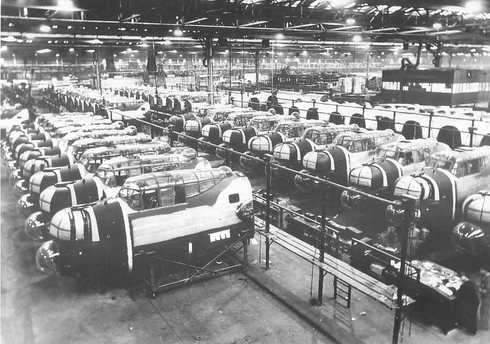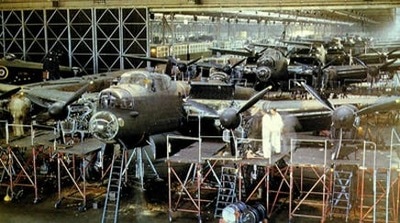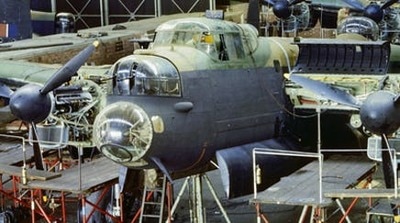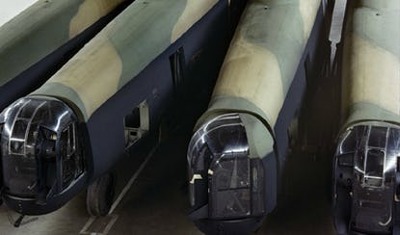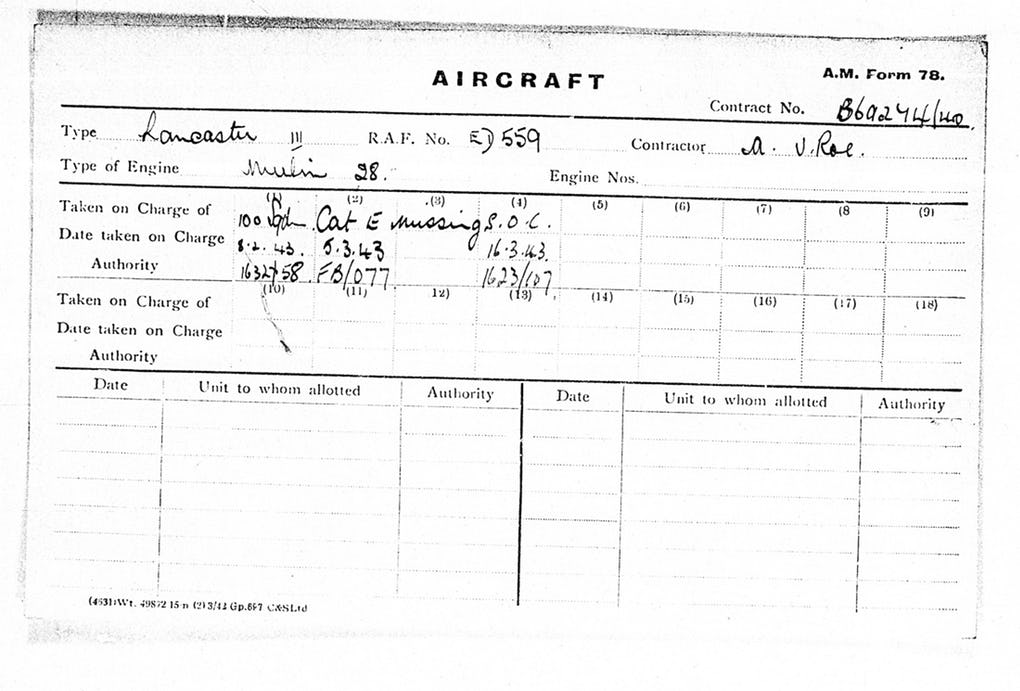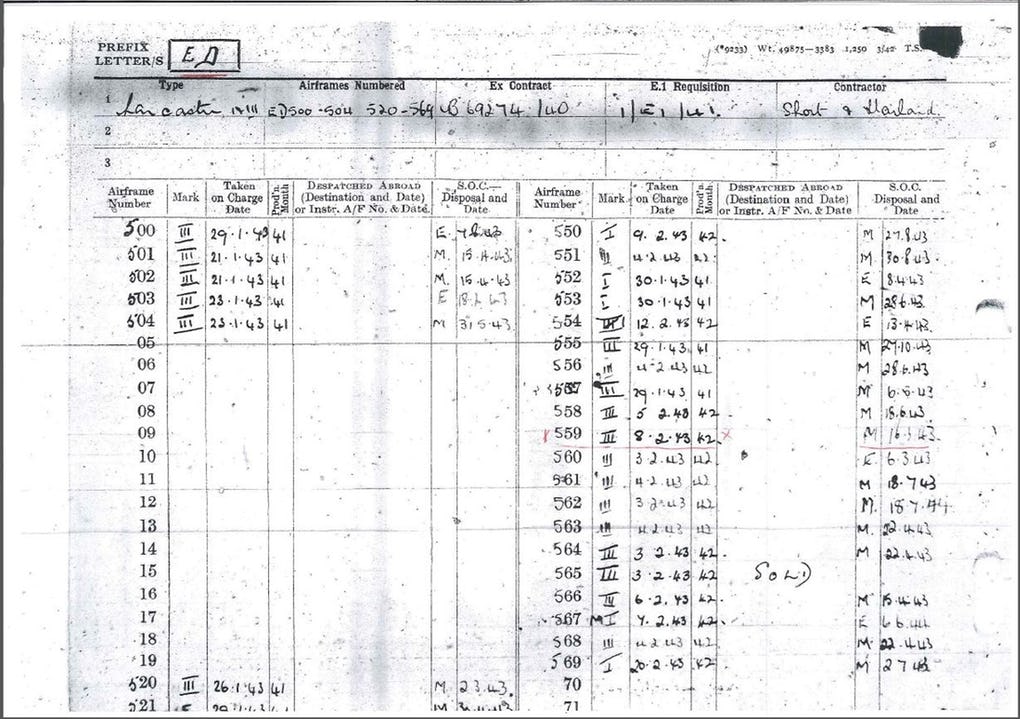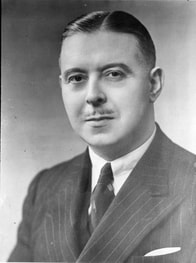The construction and delivery of Lancaster bomber ED559
|
In 1941, the Air Ministry ordered 620 Lancaster bombers from A.V. Roe & Company (Avro) as the final part of Contract No. B69274 and Works Order No. 7671.
Key to the success of the Lancaster bomber was its construction using a mid-wing cantilever monoplane and all-metal fuselage design. The Engineer magazine in 1942 reported this as enabling “ease of production, easy transport, and easy maintenance and repair." The Lancaster's wings were constructed in five main sections as was the fuselage at Avro's Chaddington factory near Oldham (approx. 25 Lancasters a week rolled off the line). The aircraft's main sections were fitted with all the necessary equipment and then transported by road for final assembly at Woodford, to the south of Manchester. The Lancaster was made of over 55,000 separate parts. |
ED559 - Avro Type 683 - was among a batch that had a serial number range between ED303 to EE202. Of the 620 aircraft constructed between November 1942 and June 1943 129 were Lancaster Mk.Is and 491 were Lancaster Mk.IIIs of which ED559 was one. Up to ED782 production was mixed between the marks but from ED783 all were Mk.IIIs. The Lancaster B Mk.III was almost identical to the earlier Mk.I but had Merlin 28 engines manufactured under licence by the Packard company in the US.
According to records held at the Avro Heritage Museum in Manchester, ED559 was delivered to RAF Grimsby on the 3 February, 1943, probably by a single pilot of the Air Transport Auxiliary (ATA), always flying with the ground in sight and using a map for navigation. The records also show that the entire squadron roster for 100 Squadron of 16 aircraft plus two reserve were delivered between 29 January and 11 February, 1943.
ED559 was officially Taken on Charge on 8 February, 1943. The Operational Report Book details that over the next few weeks 100 Squadron's 'A'-flight maintenance crews readied the 18 Lancasters for operations. During February and early March, skipper Richard Curle and his crew undertook air tests, day formation flying, cross country navigation and night flying simulations in various Lancasters at the airfield.
By the beginning of March 1943, Lancaster ED559 was ready for the squadron's first offensive operation. Richard Curle and his crew first flew ED559 on the morning of 4 March, 1943 for a test flight to Wickenby as an air test as they ironed out any remaining issues with ED559 prior to that evening's operation.
ED559 was officially Taken on Charge on 8 February, 1943. The Operational Report Book details that over the next few weeks 100 Squadron's 'A'-flight maintenance crews readied the 18 Lancasters for operations. During February and early March, skipper Richard Curle and his crew undertook air tests, day formation flying, cross country navigation and night flying simulations in various Lancasters at the airfield.
By the beginning of March 1943, Lancaster ED559 was ready for the squadron's first offensive operation. Richard Curle and his crew first flew ED559 on the morning of 4 March, 1943 for a test flight to Wickenby as an air test as they ironed out any remaining issues with ED559 prior to that evening's operation.
"The Navy can lose us the war, but only the Air Force can win it. Therefore our supreme effort must be to gain overwhelming mastery in the Air. The Fighters are our salvation, but the Bombers alone provide the means of victory."
Winston Churchill, September,1940
Lancaster ED559's Air Ministry Form 78
Every aircraft had a Form 78 which detailed its operational history.
ED559's shows that it was Taken on Charge by 100 Squadron on 8 February 1943. Category E denotes the aircraft was a complete write-off as of 5 March 1943 (this may very well be a mistake as this entry may relate to the other aircraft lost on the same operation, ED549, that crashed near Plungar whilst trying to land at RAF Langar). Missing was then added to the card. ED559 was S.O.C (Struck Off Charge) on the 16 March 1943. ED559 survived less than a month on charge; a clear example of the losses that Bomber Command suffered.
ED559's shows that it was Taken on Charge by 100 Squadron on 8 February 1943. Category E denotes the aircraft was a complete write-off as of 5 March 1943 (this may very well be a mistake as this entry may relate to the other aircraft lost on the same operation, ED549, that crashed near Plungar whilst trying to land at RAF Langar). Missing was then added to the card. ED559 was S.O.C (Struck Off Charge) on the 16 March 1943. ED559 survived less than a month on charge; a clear example of the losses that Bomber Command suffered.
ED559's air-frame document
One additional piece of information regarding ED559 from the RAF Museum Hendon archive. This gives a production month number of 42. Oddly this form has the Contractor as Short & Harland, which is surely incorrect. Data reconfirms arrival at 100 Squadron and Taken on Charge on 8 February, 1943.
The letter 'M' refers to the aircraft being missing. Those with an 'E' means the aircraft is 'Written off strength" or "Struck off charge" (akin to a write off). Interestingly, I found some information for 'EM' being used for aircraft missing from an operational sortie.
As for the Production Month being 42, this would seem to indicate that if you started in September 1939, by February 1943, this would be the 42nd month of the war.
The letter 'M' refers to the aircraft being missing. Those with an 'E' means the aircraft is 'Written off strength" or "Struck off charge" (akin to a write off). Interestingly, I found some information for 'EM' being used for aircraft missing from an operational sortie.
As for the Production Month being 42, this would seem to indicate that if you started in September 1939, by February 1943, this would be the 42nd month of the war.
"The Lancaster surpassed all other types of heavy bomber... I would say this to those who placed that shining sword in our hands - Without your genius and efforts we could not have prevailed, for I believe that the Lancaster was the greatest single factor in winning the war."
Air Chief Marshall Sir Arthur Harris to Sir Roy Dobson, AVRO, 6 December 1945
Specifications of a 1943 MK.III Lancaster bomber like ED559
|
Crew:
Seven Engines Mk.III Lancaster bombers had four Rolls-Royce Merlin 224, 12 cylinder 60 degrees vee-type liquid cooled engines with two stage supercharger. Maximum power with low gear supercharger: 1260BHP at 12,250 feet Maximum power with hightgear supercharger: 1175 BHP at 21,000 feet Airscrew: Three-bladed, 13 feet diameter, fully feathering Dimensions Wingspan: 102 feet Gross wing area: 1297 square feet Length: 69 feet 4 inches Height: 20 feet Depth of fuselage: 8 feet 2 inches Width of fuselage: 5 feet 9 inches Undercarriage Track: 23 feet 9 inches Main undercarriage wheel: 5 feet 6 inches diameter Length of bomb compartment: 33 feet Tailplane Area: 237 square feet Tail Fin and Rudder Area: 111.4 square feet |
Speed
Max at Sea Level: 245 mph Max at 15,000 feet: 275 mph Cruise at 15,000 feet: 200 mph Weights Empty Weight: 36,900 lbs. Maximum Weight: 70,000 lbs. Maximum fully loaded weight: 30 tons Operational specifications Ceiling: 20,000 feet Rate of climb: 250 ft/min Take-off to 50 feet: 4650 feet Landing from 50 feet: 3000 feet Range 2530 miles with 7000 pound bomb load 1730 miles with 12,000 pound bomb load 1550 miles with 22,000 pound bomb load Armament F.N. 5 front turret: Two 0.303 machine guns F.N. 20 rear turret: Four 0.303 machine guns F.N. 50 mid-upper turret: Two 0.303 machine guns |
A (very) short history of the Lancaster bomber
|
The prototype Lancaster (actually at the time called the Manchester III) was designed by Roy Chadwick and first flew on 9 January 1941. The requirement for a four-engine heavy bomber to add to the arsenal of aircraft attacking enemy positions was paramount. This requirement led to a rapid project of fine tuning the prototype and a production quality version of the Lancaster was ready by October 1941.
No. 44 (Rhodesia) Squadron RAF received their first Lancasters on 24 November 1941. The first operational mission commenced on 3 March, 1942 with a sea mine-laying sortie to Heligoland Bight (a bay of the North Sea, located at the mouth of the Elbe river, in Northern Germany). |
Lancaster bomber figures and numbers
The Lancaster bomber became the mainstay of RAF heavy bombers following its introduction. Between 1942 and 1945 Lancasters flew over 156,000 sorties, dropping over 600,000 tonnes of bombs. For every 100 tons of bombs dropped, nine aircrew would perish.
7,377 Lancasters were built in Canada and Britain during the war and 3,349 planes would be lost in action (3,814 in total including accidents). It cost nearly £59,000 to build a 'Lanc' (that's the airframe and engines - the armaments, radios and survival gear etc were addition costs)
Only 35 Lancasters completed more than 100 successful operations. The greatest survivor completed 139 operations and survived the war, only to be scrapped in 1947.
Average age of a Lancaster crew was 22. Over 21,000 airmen died flying the Lancaster. Ten Victoria Crosses were won in them.
7,377 Lancasters were built in Canada and Britain during the war and 3,349 planes would be lost in action (3,814 in total including accidents). It cost nearly £59,000 to build a 'Lanc' (that's the airframe and engines - the armaments, radios and survival gear etc were addition costs)
Only 35 Lancasters completed more than 100 successful operations. The greatest survivor completed 139 operations and survived the war, only to be scrapped in 1947.
Average age of a Lancaster crew was 22. Over 21,000 airmen died flying the Lancaster. Ten Victoria Crosses were won in them.

